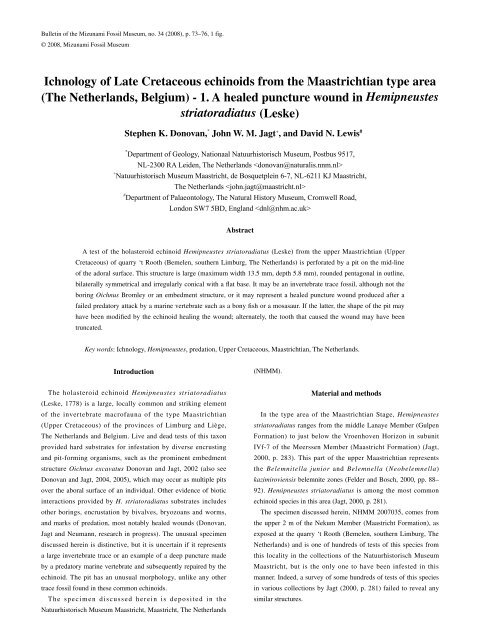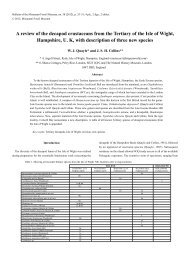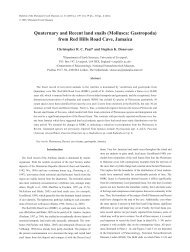Ichnology of Late Cretaceous echinoids from the Maastrichtian type ...
Ichnology of Late Cretaceous echinoids from the Maastrichtian type ...
Ichnology of Late Cretaceous echinoids from the Maastrichtian type ...
You also want an ePaper? Increase the reach of your titles
YUMPU automatically turns print PDFs into web optimized ePapers that Google loves.
74<br />
Description<br />
The test <strong>of</strong> Hemipneustes striatoradiatus is well preserved<br />
apart <strong>from</strong> a few cracks <strong>of</strong> probable post-depositional origin (both<br />
following sutures and cross-cutting plates), <strong>the</strong> pit on <strong>the</strong> adoral<br />
surface that is <strong>the</strong> subject <strong>of</strong> this description (Fig. 1), and two<br />
small, faint, teardrop-shaped depressions on <strong>the</strong> aboral surface. One<br />
<strong>of</strong> <strong>the</strong> latter is close to <strong>the</strong> apical system on <strong>the</strong> anterior column <strong>of</strong><br />
pores <strong>of</strong> ambulacrum V, whereas <strong>the</strong> second is at about mid-height<br />
<strong>of</strong> <strong>the</strong> test on <strong>the</strong> anterior column <strong>of</strong> plates in interambulacrum 4<br />
(see Melville and Durham, 1966, figs 163, 171, for explanation<br />
<strong>of</strong> relevant morphological terms <strong>of</strong> <strong>echinoids</strong>). The test is 103.8<br />
mm long, 86.2 mm wide and 67.6 mm high. The pit on <strong>the</strong> adoral<br />
surface lies on <strong>the</strong> midline, towards <strong>the</strong> posterior <strong>of</strong> <strong>the</strong> plastron<br />
and with <strong>the</strong> centre about 65.9 mm <strong>from</strong> <strong>the</strong> anterior margin. There<br />
is no indication <strong>of</strong> any o<strong>the</strong>r ancient surface abrasion or puncture.<br />
The deep pit on <strong>the</strong> adoral surface is rounded pentagonal in<br />
outline, elongated coincident with <strong>the</strong> antero-posterior axis <strong>of</strong> <strong>the</strong><br />
echinoid and approximately bilaterally symmetrical perpendicular<br />
S. K. Donovan, J. W. M. Jagt, and D. N. Lewis<br />
to this axis (Fig. 1A). The pit has a sunken rim surrounding a more<br />
circular, deeper part <strong>of</strong> <strong>the</strong> pit. This deeper part slopes down more<br />
gently on <strong>the</strong> left side <strong>of</strong> <strong>the</strong> adoral surface, in <strong>the</strong> view in Figure<br />
1A (=right side <strong>of</strong> <strong>the</strong> echinoid), than <strong>the</strong> steep right side; <strong>the</strong> latter<br />
is fur<strong>the</strong>r distinguished by two deeper depressions on ei<strong>the</strong>r side<br />
<strong>of</strong> <strong>the</strong> plane <strong>of</strong> symmetry. The base is approximately flat. This<br />
base and <strong>the</strong> sides <strong>of</strong> <strong>the</strong> depression bear primary and secondary<br />
tubercles. Maximum width <strong>of</strong> <strong>the</strong> pit is 13.5 mm, minimum width<br />
is 12.6 mm and depth is 5.8 mm.<br />
Discussion<br />
The size, position and morphology <strong>of</strong> <strong>the</strong> adoral pit are all<br />
unusual (Fig. 1). The pit is lined with test that bears tubercles,<br />
demonstrating that whatever sort <strong>of</strong> infestation it represents,<br />
it was not lethal, because <strong>the</strong> echinoid was able to repair itself<br />
subsequently. The pit is large, close in size to <strong>the</strong> trace fossil<br />
Oichnus Bromley, 1981, particularly O. excavatus, but it is<br />
bilaterally and not radially symmetrical, lacks concave walls and<br />
a central boss, and is situated on <strong>the</strong> ‘wrong’ part <strong>of</strong> <strong>the</strong> test; with<br />
Fig. 1. Puncture hole in Hemipneustes striatoradiatus (Leske), NHMM 2007035. A, Hole in <strong>the</strong> oral surface, in <strong>the</strong> mid-line and just posterior <strong>of</strong> centre; <strong>the</strong><br />
plane <strong>of</strong> symmetry <strong>of</strong> <strong>the</strong> wound is orientated left-to-right at about mid-height <strong>of</strong> <strong>the</strong> figure. Anterior <strong>of</strong> echinoid towards top <strong>of</strong> figure. B, C, <strong>Late</strong>x cast.<br />
B, <strong>Late</strong>x cast <strong>of</strong> pit in plan view, anterior towards top <strong>of</strong> page. Note <strong>the</strong> larger and smaller hollows, particularly apparent to <strong>the</strong> upper left, representing<br />
external moulds <strong>of</strong> primary (large) and secondary tubercles (small). C, <strong>Late</strong>ral view <strong>from</strong> <strong>the</strong> upper left in (B).
only rare exceptions, O. excavatus is found on <strong>the</strong> aboral surface<br />
and such a well-developed specimen is unknown <strong>from</strong> such a<br />
central position on <strong>the</strong> adoral surface. NHMM 2007035 is also<br />
more deeply impressed than an attachment scar <strong>of</strong>, for example, a<br />
benthic foraminiferan (Neumann and Wisshak, 2006). Intuitively,<br />
<strong>the</strong> position <strong>of</strong> <strong>the</strong> pit seems to be in a poor position for a large,<br />
filter-feeding, invertebrate infesting organism that was ‘hitching<br />
a ride’ on a live, furrowing, epifaunal echinoid (compare with<br />
ethology <strong>of</strong> producer <strong>of</strong> O. excavatus, as discussed by Donovan<br />
and Jagt, 2002, 2004, 2005). However, some borers appear to have<br />
thrived in analogous situations on ano<strong>the</strong>r <strong>Maastrichtian</strong> echinoid<br />
<strong>from</strong> nor<strong>the</strong>rn Germany (Wisshak and Neumann, 2006), although<br />
<strong>the</strong> borings <strong>of</strong> Caulostrepsis described <strong>the</strong>rein are very different in<br />
morphology <strong>from</strong> <strong>the</strong> present example.<br />
The trace described herein is a deep indentation on an area<br />
<strong>of</strong> <strong>the</strong> test that commonly was not available for infestation by<br />
invertebrates during <strong>the</strong> life <strong>of</strong> <strong>the</strong> echinoid. The bilateral symmetry<br />
<strong>of</strong> <strong>the</strong> pit is notable; invertebrates that form large pits in calcareous<br />
substrates tend to produce structures with radial symmetry or<br />
irregular rounded pits (e.g., parasitic eulimid gastropods; Warén<br />
and Moolenbeek, 1989). The position and morphology <strong>of</strong> this trace<br />
lead us to make <strong>the</strong> tentative suggestion that it may be vertebrate<br />
in origin, ra<strong>the</strong>r than invertebrate, and possibly represents a scar <strong>of</strong><br />
a sub-lethal predatory attack; <strong>the</strong> wound healed subsequent to <strong>the</strong><br />
attack, but evidence was preserved as a pit. This is supported by it<br />
being <strong>of</strong> comparable diameter to o<strong>the</strong>r traces deduced to have been<br />
produced by vertebrates in <strong>the</strong> same species (Donovan, Jagt and<br />
Neumann, research in progress).<br />
Mulder (2003, p. 165) provided a list <strong>of</strong> <strong>the</strong> palaeoherpet<strong>of</strong>auna<br />
<strong>of</strong> <strong>the</strong> <strong>type</strong> <strong>Maastrichtian</strong>, including mosasaurs (six species),<br />
elasmosaurid plesiosaurs, turtles (three species), a crocodile and<br />
dinosaurs (members <strong>of</strong> at least three groups based on fragmentary<br />
specimens and presumably derived <strong>from</strong> nekroplankton). To <strong>the</strong>se<br />
need to be added various fishes (Lambers, 1998; Reynders, 1998).<br />
The pit could have been made by a vertebrate with rounded, well-<br />
separated teeth, because this is <strong>the</strong> only penetrative wound in <strong>the</strong><br />
test; <strong>the</strong> distance <strong>from</strong> <strong>the</strong> circumference <strong>of</strong> <strong>the</strong> perforation to <strong>the</strong><br />
closest parts <strong>of</strong> <strong>the</strong> ambitus is about 30 mm. The tooth may have<br />
been pointed or blunt, evidence for <strong>the</strong> former being disguised<br />
by <strong>the</strong> base to <strong>the</strong> pit secreted to <strong>the</strong> echinoid. The two, teardrop-<br />
shaped indentations on <strong>the</strong> aboral surface may have been produced<br />
by two teeth <strong>of</strong> <strong>the</strong> o<strong>the</strong>r jaw failing to gain purchase and slipping<br />
across <strong>the</strong> surface. Based on <strong>the</strong>se observations and deductions, <strong>the</strong><br />
most probable culprits were a mosasaur or a bony fish; <strong>the</strong> tooth<br />
was conical, but may have been truncated, perhaps due to an earlier<br />
breakage.<br />
Mosasaur predation on shelly invertebrates was apparently<br />
rare, but well known (Kauffman and Kesling, 1960; Saul, 1979;<br />
Kauffman, 1990). Jagt (2005, fig. 1) recognised five species<br />
<strong>of</strong> mosasaur in <strong>the</strong> Nekum Member, including durophagous<br />
Carinodens belgicus, which was capable <strong>of</strong> crushing a small<br />
echinoid (Schulp, 2005, fig. 8). Without implying that it was <strong>the</strong><br />
<strong>Ichnology</strong> <strong>of</strong> <strong>Late</strong> <strong>Cretaceous</strong> <strong>echinoids</strong> <strong>from</strong> <strong>the</strong> <strong>Maastrichtian</strong> <strong>type</strong> area 1. 75<br />
predator, which remains unknown, <strong>the</strong> teeth <strong>of</strong> C. belgicus are <strong>the</strong><br />
right order <strong>of</strong> magnitude to have inflicted this wound, but are too<br />
close toge<strong>the</strong>r not to have made more than one penetration (compare<br />
with Kauffman and Kesling, 1960), unless some teeth had been<br />
lost. Larger mosasaurs with larger teeth would most likely have<br />
been able to crush <strong>the</strong> test.<br />
In conclusion, <strong>the</strong> origin <strong>of</strong> this trace fossil is uncertain. Although<br />
broadly similar to certain structures made by invertebrate borers<br />
and encrusters, its origin is uncertain. It may be that this specimen<br />
demonstrates an example <strong>of</strong> failed predation. The predator was<br />
able to puncture <strong>the</strong> test, but failed to crush it. Possible reasons for<br />
this failure include disturbance during feeding, or <strong>the</strong> test being<br />
distasteful or too big for <strong>the</strong> predator to manipulate. Based on<br />
morphology <strong>of</strong> <strong>the</strong> pit and, thus, tooth morphology (Fig. 1), <strong>the</strong><br />
predator was most probably a bony fish or a small mosasaur. But<br />
we emphasise that such an interpretation is speculative. We are<br />
unaware <strong>of</strong> o<strong>the</strong>r specimens <strong>of</strong> punctured H. striatoradiatus <strong>of</strong><br />
similar morphology <strong>from</strong> this horizon.<br />
Acknowledgements<br />
We thank Phil Crabb (Photographic Unit, The Natural History<br />
Museum, London) for taking <strong>the</strong> photographs. An informative<br />
review by Dr. Christian Neumann (Museum für Naturkunde,<br />
Humboldt University, Berlin) is gratefully acknowledged.<br />
References<br />
Bromley, R. G. (1981), Concepts in ichnotaxonomy illustrated by small<br />
round holes in shells. Acta Geològica Hispànica, 16, 55–64.<br />
Donovan, S. K. and Jagt, J. W. M. (2002), Oichnus Bromley borings<br />
in <strong>the</strong> irregular echinoid Hemipneustes Agassiz <strong>from</strong> <strong>the</strong><br />
<strong>type</strong> <strong>Maastrichtian</strong> (Upper <strong>Cretaceous</strong>, The Ne<strong>the</strong>rlands and<br />
Belgium). Ichnos, 9, 67–74.<br />
Donovan, S. K. and Jagt, J. W. M. (2004), Taphonomic and ethologic<br />
aspects <strong>of</strong> <strong>the</strong> ichnology <strong>of</strong> <strong>the</strong> <strong>Maastrichtian</strong> <strong>of</strong> <strong>the</strong> <strong>type</strong> area<br />
(Upper <strong>Cretaceous</strong>, The Ne<strong>the</strong>rlands and Belgium). Bulletin de<br />
l’Institut Royal des Sciences Naturelles de Belgique: Sciences<br />
de la Terre, 74, 119–127.<br />
Donovan, S. K. and Jagt, J. W. M. (2005), An additional record <strong>of</strong><br />
Oichnus excavatus Donovan & Jagt <strong>from</strong> <strong>the</strong> <strong>Maastrichtian</strong><br />
(Upper <strong>Cretaceous</strong>) <strong>of</strong> sou<strong>the</strong>rn Limburg, The Ne<strong>the</strong>rlands.<br />
Scripta Geologica, 129, 147–150.<br />
Felder, W.M. and Bosch, P. W. (2000), Geologie van Nederland, deel 5.<br />
Krijt van Zuid Limburg. Nederlands Instituut voor Toegepaste<br />
Geowetenschappen TNO, Delft/Utrecht, 190 pp.<br />
Jagt, J. W. M. (2000), <strong>Late</strong> <strong>Cretaceous</strong>–Early Palaeogene echinoderms<br />
and <strong>the</strong> K/T boundary in <strong>the</strong> sou<strong>the</strong>ast Ne<strong>the</strong>rlands and<br />
nor<strong>the</strong>ast Belgium – Part 4: Echinoids. Scripta Geologica, 121,<br />
181–375.<br />
Jagt, J. W. M. (2005), Stratigraphic ranges <strong>of</strong> mosasaurs in Belgium and<br />
The Ne<strong>the</strong>rlands (<strong>Late</strong> <strong>Cretaceous</strong>) and cephalopod-based<br />
correlations with North America. Ne<strong>the</strong>rlands Journal <strong>of</strong><br />
Geosciences, 84, 283–301.<br />
Kauffman, E. G. (1990), Mosasaur predation on ammonites during<br />
<strong>the</strong> <strong>Cretaceous</strong> – an evolutionary history. In Boucot, A. J.,
76<br />
Evolutionary Paleobiology <strong>of</strong> Behavior and Coevolution, pp.<br />
184–189. Elsevier, Amsterdam.<br />
Kauffman, E. G. and Kesling, R. V. (1960), An Upper <strong>Cretaceous</strong><br />
ammonite bitten by a mosasaur. University <strong>of</strong> Michigan<br />
Museum <strong>of</strong> Paleontology Contributions, 15, 193–248.<br />
Lambers, P. (1998), Beenvissen. Grondboor & Hamer, 52 (4/5), 142–<br />
143.<br />
Leske, N. G. (1778), Iacobi Theodori Klein naturalis dispositio<br />
echinodermatum, edita et descriptionibus novisque inventis et<br />
synonymis auctorum et aucta a N. G. Leske. G.E. Beer, Lipsiae,<br />
xxii + 278 pp.<br />
Melville, R. V. and Durham, J. W. (1966), Skeletal morphology. In<br />
Moore, R. C. (ed.), Treatise on Invertebrate Paleontology, Part<br />
U, Echinodermata 3 (1), pp. U220-U257. Geological Society<br />
<strong>of</strong> America and University <strong>of</strong> Kansas Press, Boulder and<br />
Lawrence.<br />
Mulder, E. W. A. (2003), On latest <strong>Cretaceous</strong> tetrapods <strong>from</strong> <strong>the</strong><br />
<strong>Maastrichtian</strong> <strong>type</strong> area. Publicaties van het Natuurhistorisch<br />
Genootschap in Limburg, 46 (1), 187 pp.<br />
Neumann, C. and Wisshak, M. (2006), A foraminiferal parasite on <strong>the</strong><br />
S. K. Donovan, J. W. M. Jagt, and D. N. Lewis<br />
sea urchin Echinocorys: ichnological evidence <strong>from</strong> <strong>the</strong> <strong>Late</strong><br />
<strong>Cretaceous</strong> (Lower <strong>Maastrichtian</strong>, nor<strong>the</strong>rn Germany). Ichnos,<br />
13, 185–190.<br />
Reynders, J. P. H. (1998), Haaien en roggen. Grondboor & Hamer, 52<br />
(4/5), 140–141.<br />
Saul, L. R. (1979), A hollow spined Anapachydiscus peninsularis with<br />
possible mosasaur bite impressions. Contributions in Science,<br />
Natural History Museum <strong>of</strong> Los Angeles County, 304, 8 pp.<br />
Schulp, A. S. (2005), Feeding <strong>the</strong> mechanical mosasaur: what did<br />
Carinodens eat? Ne<strong>the</strong>rlands Journal <strong>of</strong> Geosciences, 84, 345–<br />
357.<br />
Warén, A. and Moolenbeek, R. (1989), A new eulimid gastropod,<br />
Trochostilifer eucidaricola, parasitic on <strong>the</strong> pencil urchin<br />
Eucidaris tribuloides <strong>from</strong> <strong>the</strong> sou<strong>the</strong>rn Caribbean. Proceedings<br />
<strong>of</strong> <strong>the</strong> Biological Society <strong>of</strong> Washington, 102, 169–175.<br />
Wisshak, M. and Neumann, C. (2006), A symbiotic association <strong>of</strong> a<br />
boring polychaete and an echinoid <strong>from</strong> <strong>the</strong> <strong>Late</strong> <strong>Cretaceous</strong> <strong>of</strong><br />
Germany. Acta Palaeontologica Polonica, 51, 589–597.<br />
Manuscript accepted on September 1, 2007





